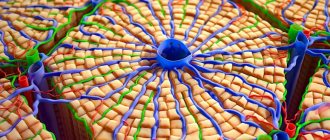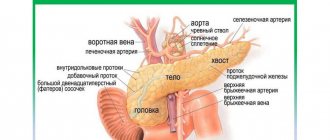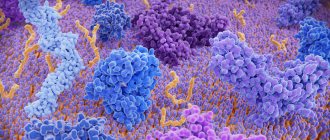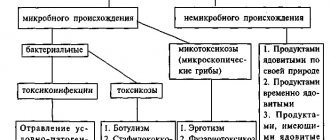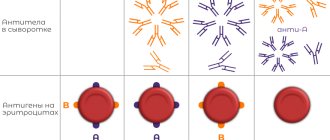The pharynx is a cylindrical, slightly compressed in the sagittal direction, a funnel-shaped muscular tube 12 to 14 cm long, located in front of the cervical vertebrae. The vault of the pharynx (upper wall) connects to the base of the skull, the back part is attached to the occipital bone, the side parts to the temporal bones, and the lower part passes into the esophagus at the level of the sixth vertebra of the neck.
The pharynx is the crossroads of the respiratory and digestive tracts. During the swallowing process, food mass from the oral cavity enters the pharynx and then into the esophagus. Air from the nasal cavity through the choanae or from the oral cavity through the pharynx also enters the pharynx, and then into the larynx.
Structure of the pharynx
In an adult, the pharynx is a funnel-shaped tube about 10–15 cm long, located behind the nasal and oral cavities and larynx. The upper wall of the pharynx is fused with the base of the skull; in this place on the skull there is a special protrusion - the pharyngeal tubercle. The cervical spine is located behind the pharynx, so the lower border of the pharynx is determined at the level between the VI and VII cervical vertebrae: here it narrows and passes into the esophagus. Large vessels (carotid arteries, internal jugular vein) and nerves (vagus nerve) are adjacent to the lateral walls of the pharynx on each side.
According to the organs located anterior to the pharynx, it is divided into 3 parts: upper - nasal, middle - oral - and lower - laryngeal.
Nasopharynx The nasal part of the pharynx (nasopharynx) serves only to conduct air. From the nasal cavity, air enters this part of the pharynx through 2 large openings called choanae. Unlike other parts of the pharynx, the walls of its nasal part do not collapse, because they are firmly fused with the neighboring bones.
Oropharynx The oral part of the pharynx (oropharynx) is located at the level of the oral cavity. The function of the oral part of the pharynx is mixed, since both food and air pass through it. The transition point from the oral cavity to the pharynx is called the pharynx. From above, the pharynx is limited by a hanging fold (velum palatine), ending in the center with a small tongue. With each swallowing movement, as well as when pronouncing guttural consonants (g, k, x) and high notes, the velum palatine rises and separates the nasopharynx from the rest of the pharynx. When the mouth is closed, the tongue adheres tightly to the tongue and creates the necessary tightness in the oral cavity, preventing the lower jaw from sagging.
Laryngeal part of the pharynx The laryngeal part of the pharynx is the lowest part of the pharynx, lying behind the larynx. On its front wall there is an entrance to the larynx, which is closed by the epiglottis, which moves like a “lifting door”. The wide upper part of the epiglottis descends with each swallowing movement and closes the entrance to the larynx, preventing food and water from entering the respiratory tract. Water and food move through the laryngeal part of the pharynx into the esophagus.
Pharynx
Pharynx
, pharynx, is the initial part of the digestive tube and respiratory tract. The pharyngeal cavity, cavum pharyngis, connects the oral and nasal cavities with the esophagus and larynx. In addition, it communicates through the auditory tube with the middle ear. The pharynx is located behind the cavities of the mouth, nose and larynx, extending from the base of the skull, from which it begins, to the junction with the esophagus at the level of the VI cervical vertebra. The pharynx is a hollow, wide tube, flattened in the anteroposterior direction, narrowing as it passes into the esophagus. The pharynx can be divided into upper, anterior, posterior and lateral walls. The length of the pharynx is on average 12-14 cm.
Depending on the organs behind which the pharynx is located, three parts are distinguished: 1) nasal, pars nasalis (or nasopharynx), 2) oral, pars oralis (or oropharynx), 3) laryngeal, pars laryngea (or hypopharynx). The upper part of the pharynx, adjacent to the outer base of the skull, is called the pharyngeal vault, fornix pharyngis.
Nasal part of the pharynx
, pars nasalis pharyngis, is its upper part and differs from other parts in that the upper and partially lateral walls are fixed to the bones and therefore do not collapse. The anterior wall of the pharynx is absent here, since in front the nasopharynx communicates with the nasal cavity through two choanae. On the lateral walls of the nasal part of the pharynx, at the level of the posterior end of the inferior concha, there is a paired funnel-shaped pharyngeal opening of the auditory tube, ostium pharyngeum tubae, which is limited from behind and above by a tubal ridge, torus tubarius. This cushion is formed due to the protrusion of the cartilage of the auditory tube into the pharyngeal cavity. A short tubal-pharyngeal fold of the mucous membrane, plica salpingopharyngea, descends from the tubal ridge. Behind the cushion, the mucous membrane forms a large pharyngeal pocket, variable in shape, recessus pharyngeus, the depth of which depends on the degree of development of the tubal tonsils. At the junction of the upper wall and the posterior wall between the pharyngeal openings of the auditory tubes in the mucous membrane of the pharynx there is an accumulation of lymphoid tissue - the pharyngeal tonsil, tonsilla pharyngea. In children it is most developed, but in adults it undergoes reverse development. The second, paired, accumulation of lymphoid tissue lies in the mucous membrane of the pharynx in front of the pharyngeal openings of the auditory tubes. It is called the tubal tonsil, tonsilla tubaria. Together with the palatine, lingual, and laryngeal lymphatic follicles, the pharyngeal and tubal tonsils form the lymphoepithelial pharyngeal ring. On the vault of the pharynx in the midline near the junction of the upper wall and the posterior wall there is sometimes a round depression - the pharyngeal bursa, bursa pharyngea.
Oropharynx
, pars oralis pharyngis, occupies the level from the soft palate to the entrance to the larynx, widely communicating through the pharynx with the oral cavity. Therefore, the oral part has only lateral and posterior walls; the latter corresponds to the third cervical vertebra. The oral part of the pharynx functionally belongs to both the digestive and respiratory systems, which is explained by the development of the pharynx (see section The doctrine of the viscera - splanchnology, this edition). When swallowing, the soft palate, moving horizontally, isolates the nasopharynx from its oral part, and the root of the tongue and the epiglottis close the entrance to the larynx. With the mouth wide open, the back wall of the pharynx is visible.
Laryngeal part of the pharynx
, pars laryngea pharyngis, is located behind the larynx at the level from the entrance to the larynx to the beginning of the esophagus. It has front, back and side walls. Outside of the act of swallowing, the anterior and posterior walls are in contact. The anterior wall of the laryngeal part of the pharynx is the laryngeal protrusion, prominentia pharyngea, above which is the entrance to the larynx. On the sides of the protrusion there are deep pits - pear-shaped pockets, recessus piriformes, formed on the medial side by the laryngeal protrusion, and on the lateral side by the lateral wall of the pharynx and the posterior edges of the plates of the thyroid cartilage. The pyriform pouch is divided by the oblique fold of the laryngeal nerve, plica nervi laryngei, into two sections - the smaller - upper, and the large - lower. The superior laryngeal nerve passes through the fold.
The nasopharynx of newborns is very small and short. The vault of the pharynx is flattened and inclined anteriorly in relation to its oral part. In addition, in newborns the pharynx is relatively shorter than in adults, and the velum palatine is in contact with the entrance to the larynx. The soft palate is short and does not reach the posterior wall of the pharynx when raised. In the first years of life, the tonsils protrude strongly into the pharyngeal cavity of newborns and children. The pharyngeal openings of the auditory tubes are close together and lie lower than in adults, at the level of the hard palate. The pharyngeal pockets, as well as the tubal ridges and tubopalatine folds, are poorly expressed.
Structure of the pharynx
. The pharynx consists of: 1) the mucous membrane, 2) the fibrous layer formed by the pharyngeal-basic fascia, 3) the muscular layer, 4) the buccal-pharyngeal fascia covering it.
Mucous membrane
The nasal part of the pharynx is covered with multi-row ciliated epithelium, and the oral and laryngeal parts are covered with multi-layered squamous epithelium. In the submucosa there is a large number of mixed (mucous-serous - in the nasopharynx) and mucous (in the oral and laryngeal parts) glands, the ducts of which open into the pharyngeal cavity on the surface of the epithelium. In addition, the submucosal layer contains clusters of lymphatic follicles that form the pharyngeal and tubal tonsils. Between the follicles there are many small glands of mixed type. At the location of the pharyngeal tonsil, the mucous membrane gives off spurs into the thickness of the tonsil, forming a series of folds and dimples, fossulae tonsillares. In the dimples of the pharyngeal tonsil there are depressions - tonsil crypts, cryptae tonsillares, into which the ducts of mixed glands located between the lymphatic follicles open.
The submucosa is well expressed, and the layer proper of tunicae mucosae contains many elastic fibers. As a result, the mucous membrane has the ability to change its size as food passes through. Near the junction with the esophagus, the pharynx narrows. In its narrow section, the mucous membrane is smooth and contains especially many elastic fibers, which ensures the passage of the food bolus here.
Pharyngeal-basic fascia
, fascia pharyngobasilaris, forms the fibrous basis of the pharynx. The pharyngeal-basic fascia begins on the outer base of the skull on the pharyngeal tubercle of the occipital bone and runs on each side transversely along a curved line anteriorly from the place of attachment of the deep layer of the anterior neck muscles along the main part of this bone to the synchondrosis retrooccipitalis. Next, the line of the beginning of the fascia turns anteriorly and outward, crosses the pyramid of the temporal bone anteriorly from the foramen caroticum externum and follows to the spina ossis sphenoidalis. From here, the line of origin of the fascia deviates forward and medially and runs along the synchondrosis sphenopetrosa in front of the cartilage of the auditory tube to the base of the medial plate of the pterygoid process of the sphenoid bone. Then it follows the medial plate of the process down and anteriorly along the raphe pterygomandibularis to the posterior edge of the linea mylohyoidea mandibulae.
In the upper section, the pharyngeal-basic fascia is very strong, since here it is strengthened by bundles of collagen fibers that go into the fascia in the form of ligaments from the pharyngeal tubercle, from the edge of the foramen caroticum externum and from the membranous plate of the auditory tube. In addition to collagen bundles, the pharyngeal-basic fascia contains many elastic fibers. Below, the pharyngeal-basic fascia is attached to the thyroid cartilage and the greater horns of the hyoid bone, giving off spurs into folds: plicae pharyngoepiglotticae and plicae epiglotticae.
Muscular membrane of the pharynx
, tunica muscularis pharyngis, consists of two groups of striated muscles: compressors, constrictores pharyngis, located circularly, PI levators, levatores pharyngis, running longitudinally. The pharyngeal constrictor muscles, paired formations, include the upper, middle and lower constrictors (Fig. 113).
Rice. 113. Muscles of the pharynx (rear view). 1 - posterior belly of the digastric muscle; 2, 8, 14 - stylopharyngeal muscle; 3 - stylohyoid muscle; 4 - medial pterygoid muscle; 5, 13 - middle pharyngeal constrictor; c - hyoid bone; 7, 10 - upper and lower horns of the thyroid cartilage; 11 - esophagus; 12 - lower constrictor of the pharynx; 15, 17 - superior pharyngeal constrictor; 16 - styloid process; 18 - main part of the occipital bone; 9, 19 - pharyngeal suture; 20 - fibrous membrane of the pharynx
1. Muscle - superior pharyngeal constrictor
, m. constrictor pharyngis superior, starts from laminae medialis processus pterygoidei (pterygopharyngeal part of the muscle, pars pterygopharyngea), raphe pterygomandibulare (buccopharyngeal part, pars buccopharyngea), linea mylohyoidea mandibulae (maxillopharyngeal part, pars mylopharyngea) and the transverse muscle of the tongue ( glossopharyngeal part, pars glossopharyngea). Starting on the listed formations, muscle bundles form the lateral wall of the pharynx, and then arc in an arcuate manner backward and medially, forming the posterior wall. Posteriorly along the midline, they meet with the bundles of the opposite side at the tendon pharyngeal suture, raphe pharyngis, running from the tnberculum pharyngeum along the middle of the entire posterior wall to the esophagus. The upper edge of the muscle - the superior constrictor of the pharynx does not reach the base of the skull. Therefore, in the upper section (over 4-5 cm), the wall of the pharynx is devoid of a muscular membrane and is formed only by the pharyngeal-basal fascia and mucous membrane.
2. Muscle - middle pharyngeal constrictor
, m. constrictor pharyngis medius, starts from the upper part of the greater horn of the hyoid bone (horns of the opharyngeal part of the muscle, pars ceratopharyngea) and from the lesser horn and lig. stylohyoideum (cartilaginous-pharyngeal part, pars chondropharyngea). The upper muscle bundles go upward, partially covering the superior pharyngeal constrictor (when viewed from behind), the middle bundles go horizontally backward (almost completely covered by the lower constrictor) and the lower ones go down (completely covered by the lower constrictor). The bundles of all parts end in raphe pharyngis. Between the middle and superior constrictors are the lower bundles of the stylopharyngeal muscle.
3. Muscle - inferior pharyngeal constrictor
, m. constrictor pharyngis inferior, starts from the outer surface of the cricoid cartilage (cricopharyngeal part of the muscle, pars cricopharyngea), from the oblique line and the adjacent parts of the thyroid cartilage and from the ligaments between these cartilages (thyropharyngeal part, pars thyreopharyngea). The muscle bundles run posteriorly in ascending, horizontal and descending directions, ending at the suture of the pharynx. The lowest bundles surround the junction of the pharynx and the esophagus. The upper constrictor is the largest, covering the lower half of the middle constrictor.
Function: they narrow the pharyngeal cavity and, with successive contractions, push through the bolus of food.
The muscles that elevate and dilate the pharynx include:
1. Stylopharyngeal muscle
, m. stylopharyngeus, originates from the styloid process near its root, goes down and medially to the posterolateral surface of the pharynx, penetrating between its superior and middle constrictors. The muscle fibers, partially intertwined with the lower and middle constrictors, go to the edges of the epiglottis and thyroid cartilage.
Function: raises and expands the pharynx.
2. Velopharyngeal muscle
, m. palatopharyngeus, see section The oral cavity itself, this publication.
The buccal-pharyngeal fascia covers the external constrictor muscles. Since the buccal muscle has a common origin with the superior constrictor (raphe pterygomandibulare), the fascia with m. The buccinator moves to the upper and then to other pharyngeal constrictors.
Syntopy of the pharynx. Behind the pharynx are the long muscles of the neck (mm. longus capitis and longus colli) and the bodies of the first cervical vertebrae. Here, between the buccal-pharyngeal fascia, which covers the outside of the pharynx, and the parietal leaf of the fasciae endocervicalis, there is an unpaired retropharyngeal cellular space, spatium retropharyngeum, which is important as a possible location of retropharyngeal abscesses. On the sides of the pharynx there is a second, paired, cellular space - the peripharyngeal space, spatium parapharyngeum, limited medially by the lateral wall of the pharynx, laterally by the branch of the mandible, m. pterygoideus medialis and muscles starting on the styloid process behind - the anterior surface of the massa lateralis atlantis and lamina parietalis fasciae endocervicalis. The peripharyngeal space, in which the internal carotid artery and internal jugular vein are located, passes posteriorly into the retropharyngeal space.
The upper poles of the thyroid gland and the common carotid arteries are adjacent to the lateral surfaces of the laryngeal part of the pharynx. In front of it is the larynx.
The blood supply to the pharynx is carried out from the external carotid artery system: the ascending pharyngeal (from a. carotis ext), the ascending palatine (from a. facialis) and the descending palatine (from a. maxillaris). The laryngeal part of the pharynx, in addition, receives branches from the superior thyroid artery: The intraorgan veins of the pharynx form venous plexuses in the submucosa and on the outer surface of the muscular layer, from where blood flows through the pharyngeal veins into the internal jugular vein or its tributaries.
Lymphatic vessels of the pharynx are formed from capillary networks lying in all layers of the pharyngeal wall. The drainage collectors go to the retropharyngeal (partially to the facial) and mainly to the deep cervical lymph nodes.
The pharynx is innervated by the branches of the vagus, glossopharyngeal and cervical sympathetic nerves, forming the pharyngeal nerve plexus on the posterior and lateral walls of the pharynx.
Interaction of the pharynx with the tympanic cavity
On the side walls of the nasal part of the pharynx, on each side there is an opening of the auditory tube, which connects the pharynx with the tympanic cavity. The latter belongs to the organ of hearing and is involved in sound transmission. Due to the connection between the tympanic cavity and the pharynx, the air pressure in the tympanic cavity is always equal to atmospheric pressure, which creates the necessary conditions for the transmission of sound vibrations. Any person has probably encountered the effect of stuffy ears when taking off from an airplane or going up in a high-speed elevator: the ambient air pressure changes quickly, but the pressure in the tympanic cavity does not have time to adjust. The ears become blocked, the perception of sounds is impaired. After some time, hearing is restored, which is facilitated by swallowing movements (yawning or sucking on a lollipop). With each swallow or yawn, the pharyngeal opening of the auditory tube opens and a portion of air enters the tympanic cavity.
Functions of the pharynx
The pharynx takes part in several vital functions of the body at once: eating, breathing, voice formation, and defense mechanisms.
All parts of the pharynx are involved in the respiratory function, since air entering the human body from the nasal cavity passes through it.
The voice-forming function of the pharynx is to form and reproduce sounds produced in the larynx. This function depends on the functional and anatomical state of the neuromuscular apparatus of the pharynx. During the pronunciation of sounds, the soft palate and tongue, changing their position, close or open the nasopharynx, ensuring the formation of timbre and pitch of the voice.
Pathological changes in voice can occur due to impaired nasal breathing, congenital defects of the hard palate, paresis or paralysis of the soft palate. Nasal breathing impairment most often occurs due to an enlargement of the nasopharyngeal tonsil as a result of pathological proliferation of its lymphoid tissue. The growth of adenoids leads to an increase in pressure inside the ear, while the sensitivity of the eardrum is significantly reduced. The circulation of mucus and air in the nasal cavity is inhibited, which promotes the proliferation of pathogens.
The esophageal function of the pharynx is to form the acts of sucking and swallowing. The protective function is performed by the lymphoid ring of the pharynx, which, together with the spleen, thymus and lymph nodes, forms a single immune system of the body. In addition, there are many cilia on the surface of the pharyngeal mucosa. When the mucous membrane is irritated, the muscles of the pharynx contract, its lumen narrows, mucus is released and a pharyngeal gag-cough reflex appears. With a cough, all harmful substances adhering to the eyelashes are expelled.
The structure and significance of the tonsils
In the nasal part of the pharynx there are such important formations as the tonsils, which belong to the lymphoid (immune) system. They are located on the path of possible introduction of foreign substances or microbes into the body and create a kind of “security posts” on the border of the internal and external environment for the body.
The unpaired pharyngeal tonsil is located in the area of the fornix and posterior wall of the pharynx, and the paired tubal tonsils are located near the pharyngeal openings of the auditory tube, i.e., in the place where microbes, along with the inhaled air, can enter the respiratory tract and tympanic cavity. Enlargement of the pharyngeal tonsil (adenoid) and its chronic inflammation can lead to difficulty in normal breathing in children, so it is removed.
In the area of the pharynx, at the border of the oral cavity and pharynx, there are also paired palatine tonsils - on the side walls of the pharynx (sometimes in everyday life they are called tonsils) - and the lingual tonsil - at the root of the tongue. These tonsils play a significant role in protecting the body from pathogens that enter through the mouth. With inflammation of the palatine tonsils - acute or chronic tonsillitis (from the Latin tonsilla - tonsil) - there may be a narrowing of the passage to the pharynx and difficulty swallowing and speech.
Thus, in the pharynx area, a kind of ring of tonsils is formed, which participate in the body’s defense reactions. The tonsils are significantly developed in childhood and adolescence, when the body grows and matures.
quiz
1. Why is the pharynx considered part of the digestive system and the respiratory system? A. The pharynx provides innervation to both the digestive and respiratory systems. B. The pharynx is located near the entrance to the trachea and esophagus. C. The pharynx forms a physical connection that connects the air tract and the digestive tract D. A & C
Answer to question #1
B is correct. The pharynx is the part of the mouth and nose that immediately precedes the entrance to our respiratory tract through the trachea and the intestinal tract through the esophagus.
2. What is the main difference in the types of muscles that lie in the outer muscle layer of the pharynx compared to the inner muscle layer? A. The outer layer has latissimus muscles compared to the types of circular muscles in the inner layer B. The outer layer has circular muscles compared to the longitudinal muscles in the inner layer C. Only the outer layer is controlled by the vagus nerve D. The inner layer is not controlled by the parasympathetic nerves
Answer to question No. 2
B is correct. The outer muscular layer of the pharynx consists of circular muscles, which act as constrictors compared to the longitudinal muscles of the inner layer. The vagus nerve (parasympathetic nerve) innervates both types of structures.
3. Which artery supplies the pharynx? A. Pharyngeal plexus B. Internal carotid artery C. External carotid artery D. IJV
Answer to question number 3
C is correct. The external carotid artery branches into several smaller arteries that supply different areas of the pharynx. The pharyngeal plexus, on the other hand, is a venous drainage that drains from the pharynx into the IJV, eliminating these answer options.
Structure of the pharyngeal wall
The basis of the pharyngeal wall is formed by a dense fibrous membrane, which is covered on the inside by the mucous membrane and on the outside by the muscles of the pharynx. The mucous membrane in the nasal part of the pharynx is lined with ciliated epithelium - the same as in the nasal cavity. In the lower parts of the pharynx, the mucous membrane acquires a smooth surface and contains numerous mucous glands that produce a viscous secretion, which helps the bolus of food slide when swallowing.
Among the muscles of the pharynx, longitudinal and circular are distinguished. The circular layer is much more pronounced and consists of 3 constrictor muscles (constrictors) of the pharynx. They are located in 3 floors, and their sequential contraction from top to bottom leads to the pushing of the food bolus into the esophagus. When swallowing, two longitudinal muscles expand the pharynx and lift it towards the bolus of food. The muscles of the pharynx work in concert with every swallowing movement.
Definition of pharynx
The pharynx is a five-inch tube that starts at our nose and ends at our breathing tube. The pharynx is generally considered to be part of the throat in vertebrates and invertebrates. In humans, it is a hollow structure (or muscular cavity) lined with moist tissue. This is common to all structures in our digestive tract. Having a moist lining with a mucus-rich barrier allows us to breathe and move safely through our canal without damaging sensitive tissue. The muscular pharynx effectively forms the entrance to the esophagus, or our “food canal,” and the trachea, also known as our “breathing tube.” For this reason, the pharynx is considered part of our respiratory and digestive systems.
How does swallowing occur?
Swallowing is a reflex act, as a result of which a bolus of food is pushed from the mouth into the pharynx and then moves into the esophagus. Swallowing begins with food irritating the receptors in the oral cavity and the back wall of the pharynx. The signal from the receptors enters the swallowing center located in the medulla oblongata (brain section). Commands from the center are sent through the corresponding nerves to the muscles involved in swallowing. The bolus of food, formed by the movements of the cheeks and tongue, is pressed against the palate and pushed towards the pharynx. This part of the act of swallowing is voluntary, that is, it can be suspended at the request of the swallower. When a bolus of food reaches the level of the pharynx (at the root of the tongue), swallowing movements become involuntary.
Swallowing involves the muscles of the tongue, soft palate and pharynx. The tongue moves the food bolus, while the velum palatine rises and approaches the back wall of the pharynx. As a result, the nasal part of the pharynx (respiratory) is completely separated from the rest of the pharynx by means of the velum palatine. At the same time, the neck muscles lift the larynx (this is noticeable by the movements of the protrusion of the larynx - the so-called Adam's apple), and the root of the tongue presses on the epiglottis, which descends and closes the entrance to the larynx. Thus, when swallowing, the airways are closed. Next, the muscles of the pharynx itself contract, causing the bolus of food to move into the esophagus.
Muscular components of the pharynx
In terms of the muscles that make up the pharynx on a microscopic level, there are two muscle structures. The outermost layer consists of the orbicularis muscles, which function as constrictor muscles. The circular muscles essentially squeeze or compress our “tube,” which in this case is our pharynx. In each of the sections of the pharynx, on the outermost layer are the pharyngeal constrictor muscles, each of which is innervated by our vagus nerve (an extremely important parasympathetic nerve associated with the heart, lungs and intestinal tract). The muscles that lie underneath this outer layer are our internal longitudinal muscles. They consist of three muscle bands that stretch for some distance and are noticeably different from the circular extrinsic muscles. For example, the layer Palatopharyngeus extends from the hard palette to the pharynx. However, quite similar to the outer layer is the fact that two of the three inner muscle layers are also innervated by the vagus nerve.
The blood that feeds the muscles of the pharynx comes from the external carotid arteries, which branch into several arteries, each of which will supply different muscle areas in the pharynx. This blood will eventually drain into a network of tiny veins known as the pharyngeal plexus, which will flow into the internal jugular veins (IJVs), which run along our neck.
Structure of the oropharynx
The mesopharynx is the middle part of the pharynx, has a smooth transition from the nasopharynx. The oropharynx is, in fact, its continuation. In the human oropharynx there are:
- human soft palate,
- palatine arches,
- back of the tongue.
The dorsum of the tongue separates the oropharynx from the oral cavity. The soft palate or vault of the pharynx is responsible for the most important functions of the body. The soft palate facilitates the swallowing process by blocking the airways. The soft palate also allows for the correct formation of sounds. The oropharynx prevents food from entering the nasopharynx, which is very important for normal breathing.
Anatomical structure of the larynx
The larynx (larynx) is lined with various tissue structures, blood and lymphatic vessels, and nerves. The mucous membrane, covered from the inside, consists of multilayered epithelium. And underneath there is connective tissue, which in case of illness manifests itself as swelling. When studying the structure of the throat and larynx, we observe a large number of glands. They are absent only in the region of the edges of the vocal folds.
See the photo below for the structure of the human throat with a description.
The larynx is located in the throat in the shape of an hourglass. The structure of the larynx in a child differs from that of an adult. In infancy, she is two vertebrae higher than normal. If in adults the plates of the thyroid cartilage are connected at an acute angle, then in children they are at a right angle. The structure of the larynx in a child is also distinguished by a long glottis. In them it is shorter, and the vocal folds are of unequal size. The diagram of a child’s larynx can be seen in the photo below.
What does the larynx consist of?
The structure of the larynx in relation to other organs:
- superiorly, the larynx is attached to the hyoid bone by thyroid ligaments. This provides support for the external muscles;
- below, the larynx is attached to the first ring of the trachea with the help of the cricoid cartilage;
- on the side it borders on the thyroid gland, and on the back on the esophagus.
The skeleton of the larynx includes five main cartilages that fit tightly together:
- cricoid;
- thyroid;
- epiglottis;
- arytenoid cartilages - 2 pieces.
From above the larynx passes into the laryngopharynx, from below into the trachea. All cartilages found in the larynx, except the epiglottis, are hyaline, and the muscles are striated. They have the property of reflex contraction.
What functions does the larynx perform?
The functions of the larynx are determined by three actions:
- Protective. It does not allow third-party objects into the lungs.
- Respiratory. The structure of the larynx helps regulate air flow.
- Voice. The vibrations caused by the air are created by the voice.
The larynx is one of the important organs. If its functional activity is disrupted, irreversible consequences may occur.
Diseases of the pharynx
The pharynx is one of the most important human organs, changing with age, and is responsible for several body functions necessary for a normal healthy human life . This part of the body, like others, is not spared by various diseases, of which, despite the complex anatomical structure of the pharynx, there are not so many.
Common diseases of the pharynx are:
- Adenoids . Enlargement of the adenoids occurs against the background of frequent colds, and is not so much a disease of the pharynx as an anomaly of it. If a person often catches a cold in childhood, then pathological growth of lymphoid tissue occurs in the area of the pharyngeal tonsil, which requires immediate consultation with a doctor and proper treatment. According to observations, most often such changes occur in children aged 2 to 10 years, and upon reaching the age of 18 years, the threat of proliferation of lymphoid tissue decreases sharply. Delayed treatment or its absence is fraught with complications in the form of a wide range of diseases from the thyroid gland to the heart.
- Laryngitis, pharyngitis, sore throat . These diseases are complications caused by bacteria and viruses. Any part of the throat can become infected. Delayed treatment or lack thereof can also cause complications in the thyroid gland and cardiovascular system.
- Retropharyngeal abscess . A retropharyngeal abscess is a purulent inflammation of the tissue and lymph nodes in the retropharyngeal region. Therapy depends on the causes of the disease. One of the main causes of this disease in children is the presence of infection in the nasopharynx. Any disease can give an impetus, for example, flu, tonsillitis, sinusitis, ARVI, otitis media. In adults, injuries to the pharynx, for example, from solid food.
- Candidiasis . Pharyngeal candidiasis is a type of thrush, which is a fungal disease. Newborns and young children are very prone to this disease. If an adult suffers from this disease, this indicates a complete disruption of the functioning of his immune system.
- Developmental anomalies . The origins of abnormalities in the development of the pharynx in humans are not fully understood; scientists have a lot of unresolved questions on this topic. The fact that this organ is malformed in a person becomes known immediately after childbirth. Treatment is surgical and is usually indicated in the first years of life.
If a person is overtaken by an illness, then you need to forget about self-medication and go to see a doctor . Any diagnosis must be carried out by a specialist with a higher medical education, and he must also treat the patient.
Anatomical features
If you correlate the pharynx with the human skeleton, then it is located along the cervical vertebrae, not far from the thyroid gland. The pharynx begins at the base of the skull and ends in the region of the 4th–5th vertebrae, at the very beginning of the esophagus and thyroid gland. The posterior wall of the pharynx is attached to the occipital part of the skull. The walls of the pharynx are attached to the temporal bones.
As already mentioned, the pharynx combines two vital functions at once - respiratory and digestive. It is in the pharynx that these paths intersect, however, everything is arranged in such a way that only food reaches the esophagus, while air, on the contrary, goes through the respiratory tract.
The structure of the nasopharynx is designed in such a way that while the swallowing function is not active, the airways are completely open.
However, at the moment when the chewed lump of food is directed towards the esophagus, the muscles of the larynx completely block the airways. In this cunning way, food reaches the esophagus, bypassing the breathing hole.
However, in fact, bringing food to the esophagus and pushing air into the lungs is not all the functions of the pharynx. In fact, the walls of the pharynx, and its entire cavity as a whole, contain a large amount of lymphoid tissue. In some places it grows, forming tonsils. So these same tonsils are the most important part of the human immune system.
In fact, the tonsils contain active immune cells that destroy all pathogenic bacteria that come to them.
The pharynx is actually the gateway to the human body and everything that reaches the esophagus and then enters our body through the pharynx.
